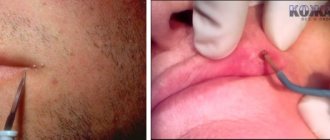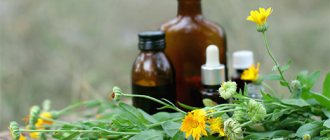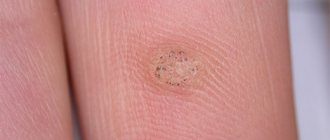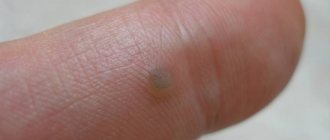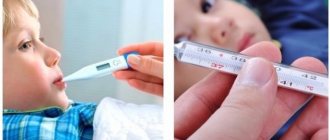08/23/2020 Alena Masheva Health
Before answering the question of why a wart appears and itches, what to do, you need to figure out what kind of formation it is. Warts (neoplasms on the skin), as a rule, do not pose any threat to the life of an individual. Sometimes they can disappear on their own, as suddenly as they appeared. But in situations where the growths cause itching or pain, you should sound the alarm and rush to the doctor. There are cases when a patient began bleeding, through which the infection spread.
Why does a wart itch?
Doctors identify several main causes of itching in the area of skin growth:
- complications caused by the “transformation” of papilloma into a malignant form;
- injury to healthy skin (with an increase in wart size).
Danger
If the elements itch, do not comb the skin, it can lead to serious consequences:
- development of the inflammatory process;
- infection of dermal cells;
- formation of scars, cicatrices;
- spread of virus cells to healthy tissues, which provokes the growth of new formations;
- bleeding.
When scratching a lump on the skin, there is a risk of foreign infection entering the bloodstream, which can lead to inflammation and worsening the patient’s well-being.
If the formation begins to itch, turn red, increase in size, or blurred boundaries are observed, then you need to consult a doctor.
The doctor will decide whether there is a need for surgical removal or whether antiviral drugs and pharmaceutical cauterization agents can be used.
Transition to a malignant form
Modification of a neoplasm into a malignant form occurs extremely rarely.
Most often, discomfort associated with itching is caused by growths that are located on the tips of the fingers, in the groin areas, as well as in places where nerve endings are localized and on the hands. Warts on the body often itch. Unreasonably caused and incessant itching in the area where the growth is located requires urgent qualified medical consultation - for an accurate diagnosis of the disease and, if necessary, the necessary medical intervention.
Those who ask the question of whether warts itch should know that constant itching is dangerous. This is especially true in cases where continuous itching goes hand in hand with other acute symptoms, such as pain, changes in the size of the tumor and color.
Continuous scratching can be caused by an increase in the size of the wart, which may result from a weakened immune system. First of all, this is due to the fact that in the active phase of viral processes in the human body, as well as on healthy skin, a visual change occurs in its healthy cells. This process is often accompanied by a number of unpleasant sensations.
So, if a wart itches, it is most likely growing.
Diagnosis of itchy growth
If the growth causes discomfort, pain, bleeds or itches, you need to go to a dermatologist. To make a diagnosis and determine the type of wart on the dermis, the doctor conducts an examination and, if necessary, sends the patient for tests:
- PCR (polymerase chain reaction) to determine the type of virus and its quantity in the human body. They take fingerprints.
- Histology. Tissue removed from a plantar or other wart is sent for examination to determine its nature and the presence of cancer cells.
Flat, convex tubercles on the dermis, which are often exposed to ultraviolet radiation, are injured, rubbed by clothing or shoes, require special attention.
Is it possible to scratch the tumor?
If a wart appears and itches, it causes a painful tickling sensation, but giving in to the desire and scratching the growth is strictly prohibited. As a result of such manipulations, the following can happen:
In cases where the wart just begins to itch, you should not even rub it. This can cause new growths to appear throughout the body. If the neoplasm is nevertheless injured, it must be treated as soon as possible with any antibacterial drug, and then covered with a band-aid. Immediately after treatment, you should show the wart to a doctor and thereby exclude the possibility of infection of other skin cells.
Medicines for itching
When a wart itches , the doctor may prescribe antipruritics in the form of ointments, creams and special gels. For patients with dry skin, fatty ointments with a cooling effect are more suitable; for people with normal or oily skin types, gels, creams and tinctures are more suitable. Complex drugs with antiallergic properties help very well.
The most popular ointments for itching:
- Pimecrolimus is a cream for external use.
- Akriderm - available in the form of cream and ointment.
- Mesoderm - ointment.
- Iricar - sold in the form of ointment and cream.
- Nezulin - cream-gel.
Perhaps a malignant tumor?
As is already known, the transformation of a wart from a benign form to a malignant one is very rare. But let us dwell in more detail on the main symptoms of oncology in order to protect ourselves from irreparable consequences.
One of the most obvious symptoms is a change in the growth to a darker color.
If the formation is oncological
An oncological tumor that can be detected at a very early stage of development is called melanoma. The most obvious symptom accompanying the disease is itching of the skin. That is why it is necessary to consult a doctor if such symptoms occur.
The main signs of a malignant tumor include:
The transformation of a wart from a benign to a malignant form is influenced by a number of factors:
When visiting a doctor, the first thing the patient needs is a visual examination, which allows a qualified specialist to accurately determine the type of tumor. It is extremely rare, but still sometimes the dermatologist gives the patient a referral for additional examinations: PCR analysis and histological analysis. There are cases when doctors confused plantar growths with dry callus, which triggered the start of an irreversible process.
Prevention of warts
A healthy lifestyle is the true key to success in everything. The body's immune system deserves special attention. Here are some additional recommendations:
Definition
Warts are benign growths caused by the human papillomavirus, which is carried by eighty-five percent of the world's population. They can appear on both the skin and mucous membranes.
You can become infected with HPV in the following ways:
- Having minor damage to the skin. Through handrails in transport, a handshake, or a visit to public saunas, swimming pools or baths.
- During unprotected sex.
- During childbirth. A child becomes infected with papilloma while passing through the birth canal.
Treatment of warts
Doctors identify a number of general methods for treating neoplasms:
Reviews about therapy
Before starting treatment, it is advisable to read reviews about a particular method. They are all quite different. Therefore, we can conclude that in order to get rid of such a problem, the individual characteristics of the body should be taken into account. Some were helped by a specific drug, others required surgery. So, in order not to start the process, you should resort to medicinal methods (liquid nitrogen, etc.), which will be recommended by the doctor. Only this will help completely remove the growths.
It is equally important to take preventive measures. First of all, it strengthens the immune system. To do this, you can use both medications and folk remedies. Particular attention should be paid to vitamins. Proper nutrition and a healthy lifestyle are the key to a strong body.
And lastly, stress. It is known to cause 95% of diseases. And warts are no exception. Stress less and relax more. And then diseases will be avoided.
The question of why a wart hurts can only be answered most competently by a doctor, whom you should contact in this case. A wart is a rather unpleasant disease caused by the papilloma virus in the human body. But it’s even more difficult when a growth that appears on the body begins to cause a lot of unpleasant sensations in the form of severe itching or pain.
Medication methods for eliminating warts
If a neoplasm appears on the skin, you should seek help from a dermatologist. As a rule, the first thing he does is prescribe a number of drugs that actively increase immunity, calm the nervous system and enrich the body with vitamins. Moreover, only a qualified specialist will be able to select the most suitable method for eliminating unwanted growth.
In medicine, the following methods of combating warts are shared:
Patients are often recommended to use the following medications:
It is strictly forbidden to use any of the above medications without consulting a doctor; self-medication is inappropriate here.
What symptoms should you see a doctor for?
Constant itching in the area of education is a reason to consult a doctor. The symptom may indicate inflammation of a flat or raised growth on the skin.
Signs of wart inflammation:
- bleeding of the formation and the area of skin around it;
- change in size, color, shape, blurring of boundaries;
- rapid growth on the skin;
- sensation of pain, itching in the area of the wart;
- swelling of the tubercle, sharp redness or darkening.
Most doctors advise removing growths that itch not with pharmaceutical drugs or folk remedies, but in a hospital setting using the following methods:
- Cryodestruction or cauterization with liquid nitrogen.
- Laser therapy.
- Radio waves.
- Surgical excision.
- Diathermoelectrocoagulation.
The appearance of moles and other bumps on the skin is not always a lucky sign. Any points on the skin require observation and care; they should not be combed, picked, or removed with pumice or scrubs. If a person experiences frequent discomfort, he should visit a doctor.
